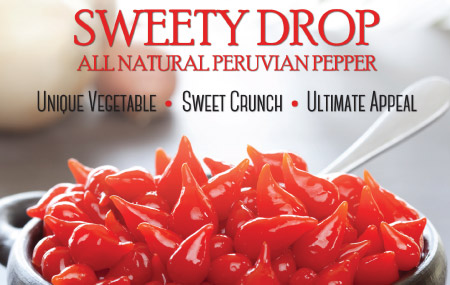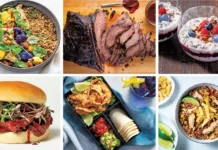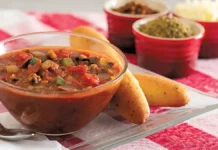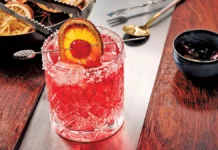
It’s a dog-eat-dog world out there. So how do you differentiate your foodservice import and distribution business from everyone else? If you’re Atalanta Corporation, you find specialty food products from all over the world before anyone else, educate your customers about them, then show them ways they can use these new products in multiple ways on their menus, all while keeping costs down.
According to John Stephano, director of marketing and training, when the company started in 1945, it chose Atalanta, the goddess of speed and hunting, to represent its prowess in securing the most unique products from around the globe and its ability to get them to customers quickly and easily.
“What our product managers do really well is source products,” he says. “We find unique products from throughout the globe and we get them to our foodservice customers in the highest quality and the most competitive price. We as an importing company go out to our suppliers and find the most innovative and trend setting specialty foods, the products that are going to add value to our operators and distributors in a very competitive marketplace .”
Atalanta began importing Krakus Polish hams almost 70 years ago, he notes. “We were an importer of goods from Eastern European countries, behind the Iron Curtain, and political maneuvering was key. Atalanta needed to master the uniqueness and process of importing really well.”
“And our founders did that better than anyone else in the industry.”
Stephano says the company, because of our rich history and commitment to their customers, believes no one else can source, import and then get product to its distributors faster than Atalanta can. “It could be Parmigiano Reggiano from Italy, Collier’s Welsh Cheddar from Wales. It could be saffron from Spain, artichokes from Peru. Over the last 70 years, we’ve developed a logistics, importing and product awareness process that finds these unique foods, gets them to customers first and helps them beat their competition to the marketplace, allowing them to see clearly the value we add.”
Today, with competition so intense – and margins so tight – to make yourself stand out is paramount, Stephano says. And the company, which serves every foodservice sector from chain restaurants to institutions, white tablecloth to quick-serve – does it through finding the right food products no one has or has ever heard of, then distributing quicker and more cost effective than anyone else.
He likes to cite the Sweety Drop pepper from Peru as an example. “We now do a significant amount of market trend analysis, so we get a chance to see trends often before they hit the consumer. We see them on two levels – either from an increased category volume demand or from our specialty stores focused product selection. Right now, Peruvian and South American cuisine is super hot. Chefs all over the country are pressing for this pepper. White tablecloth restaurants want to garnish it on premium flat breads, or dress it on a specialty pizza, or even drop it into a trendy cocktail. We also are seeing an enormous volume increase in the Piquillo pepper. Several of our chain restaurants’ customers are currently in menu development with many of these South American products feverishly trying to get them on their menus. Our Chefs are just begging for it. We can get it for them. We get to go to market quicker and faster than others,” he says.
Stephano loves to tell the story of how Atalanta found the Sweety Drop pepper. “It’s a lagrima, teardrop shaped, pepper and it was found in the Amazon rainforest. One of our outstanding suppliers in Peru discovered it a couple of years ago. He brought it back to Peru and started to cultivate it. Because of the strength of our relationship, he reached out to us immediately knowing we had the capability to get to customers’ tables and ultimately the ever demanding public better than anyone else in the industry. Our excellent sales team took over from there they put feelers out into the US market and began to create a market. Our culinary team then brought it to the Research Chefs Association Show in Portland this past spring, and the Chefs could not stop tasting and gazing at it. The color is brilliant red. The crunchy texture sweet flavor profile with just a hint of heat is very sexy. Right there our customers started a trend. We are just glad to be a part of what is happening.
“Every time they put it in their mouths, they came up with a new concept or recipe. One Chef says, pepper vodka cocktails. Another says a rustic Spanish flat bread with baby arugula and shaved Manchego cheese and throw these Sweety Drop peppers on top,” says Stephano. “A chef worked with me to develop a goat cheese stuffed Piquillo pepper recipe where we use ancient grain farro, crumbled Canadian goat cheese, olive oil, lemon juice and the Sweety Drop pepper and stuff it into a beautiful red Peruvian Piquillo pepper.”
Stephano, a Chef himself, says their event team is actually working on using these peppers in not only savory recipes but sweet applications like panna cotta. “You can use the Sweety Drop in side dish applications, salads, garnishes, and there’s a very real possibility for some unique sweet applications. There’s this big huge fusion of flavors now of sweet and savory and this pepper fits ideally.”
Stephano is really excited about a new demographic that’s helping the company stretch and expand its networks and customers. “We’re talking about the millennials,” he says. “Years ago, if a food company wanted to launch a product, you’d go to the international food shows, study the demographics, evaluate pricing metrics and packaging, then after a long time hopefully release it. Today a young couple goes on a date in Portland at a hot new restaurant, where we are seeing a lot of new trends develop, and the Chef introduces an appetizer special using our black flour in a rustic pizza. They love it, they need to know the passion of its origin, they take a picture, post it instantaneously on Facebook or Instagram and it goes viral to their foodie friends. Next, one of their friends from college, in let’s say Philly, sees it and she’s going on a date the next day and she goes to the Chef and says, “I WANT THIS can you make it?”
“In less than 24 hours your brand new specialty food product just traveled 4,000 miles and the Chefs of these chain restaurants and menu developers of these white table cloth hot spots just throw up their hands in disbelief. Our industry now has no choice but to quickly understand this new arena and quickly adjust to the speed to which our customers desire these products,” he says. He adds that Atalanta is in a unique position to capitalize on this.
“Because of our network of suppliers, growers across the globe and awareness of developing trends, we’re the ones whose salespeople introduce it through our distributors faster than you can blink. We used to be able to launch a product. Now millennials and today’s foodies are discovering these foods and simply demanding them. There is no time any more to launch and release a product. You have to be first to market, offer specialty and high-end products today and that’s where we shine. Millennials are in control of the flavors, trends and stories today and will be for the forseeable future.”
Stephano says where his company really differentiates itself from others is in its ability to help Chefs and Buyers use its products in many different culinary applications. “If we sell a Chimay beer cheese, or a Danish crumbled blue cheese, we provide our customers with recipes and culinary ideas using those products. We teach them how to take it and develop an exceptional three cheese soufflé as apposed to just showing how it looks beautiful on a premium cheese board – We need to offer and share multiple ways to use this product from the appetizer course through the dessert course. By doing this, Chains can drive down costs because they now use these products through the entire spectrum of the menu.”
It’s particularly important for foodservice operations who may have to order expensive cheeses, then throw them out when they’re not used in time for other dishes. “Think Parmigiano Reggiano. It’s a gorgeous product, with a rich Italian history of over 750 years, probably the most well known specialty cheese on the planet. But here’s what happens in the back of the house. They order a whole wheel of it, and it’s pricy, maybe around $1,600. They have a wedding, a huge catering event or a corporate conference, and they crack the wheel and chunk it into beautiful wedges. They pair it with fresh fruit and fantastic wines on a banquette table. It becomes the centerpiece of the catering event.
“People get excited about it. ‘Where did you get this?’ ‘Ooh, this is so-oo good!’ They tell their friends, try this cheese, it comes from this unique dairy in Parma. Now, That’s what everyone in our industry has done really well. But here’s what happens next. The catering event is over, the guys in the back of the house take the cheese and wrap it and then throw it in the walk-in. The sous-chef comes back two weeks later, the cheese is dried out or has mold all over it, puts it on the prep table, then looks at it and he gets upset because the product wasn’t taken care of and most importantly doesn’t know how else to use the cheese other than grating it on top of pasta, so he throws it away. The last experience the sous-chef has with one of our specialty food products is throwing it in the trash. There’s no other industry in the world where you could get away with that.”
So what does Atalanta do about that? “We introduce, teach, and offer culinary applications. Meaning, we had a great party, used this premium cheese, now what do I do with it? We have to teach them how to use this in soups, in baked dishes, and how to use this in as many culinary apps as we can,” Stephano says. “Now we’ve truly provided value to the product. We need to be able to take our specialty products and power the entire menu. And that’s what we’re doing.” Stephano says that what Atalanta is now bringing to the table is a teaching-tool and a cost-saving product.
“We’re teaching the passion behind it, the story behind it, and the culinary app behind it. We want to offer you an artisanal aged Mahon from Spain and we want to see that on all your specialty cheese boards. But if we’re not teaching you how to use that cheese with small plates and tapas or how to take the cheese and put it in a high-end grilled cheese sandwich or how to incorporate that into a specialty salad, we’ve really missed an opportunity, and then we’re just selling products.”
Stephano says the company’s goals are to offer culinary solutions to its customers. “And the hottest way to do that is to teach them what’s happening from a trend basis, offer them multiple uses of a product and teach them the passion and culinary apps behind it. Ultimately, when we do that, we help our customers increase their margins and ultimately their profits.”
























